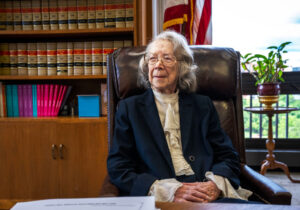Third Time's The Charm: Dr. Aaron Filler Discusses Findings In Pauline Newman Case
Prepare to take notes!

(Photo by Bill O’Leary/The Washington Post via Getty Images)
Pauline Newman’s recent test is being touted as a proof that she is fit to serve on the U.S. Court of Appeals for the Federal Circuit, but how does this differ meaningfully from the two other highly decorated doctors who have said the same thing? We sat with Dr. Aaron Filler — who’s a neurosurgeon, lawyer, and the 13th President of the Society for Brain Mapping and Therapeutics — to talk about what his new report could mean for Newman’s role as a judge moving forward.
Here is a (lightly edited and condensed) write-up of our conversation about Newman, the usefulness of brain imaging, and where the U.S. Court of Appeals for the Federal Circuit can go from here.

Thomson Reuters' Claims Explorer: A Powerful Tool For Legal Claim Identification

Chris: So, What’s the main difference between what a neurologist does and what a neurosurgeon does?
Dr. Filler: One of the big differences is that neurologists don’t actually look at images. It is very important. So the radiologist looks at images and they don’t see patients, so they’re often disembodied from the task like neurologists. They see patients, but they don’t look at images. So they are entitled entirely to look at the report of the radiologist. And they may recognize everything, but they would not really, almost never will. Very few of them will actually try to do a reading of an image. Neurosurgeons are in a different situation. The way I like to explain this is we are allowed to consider the opinion of a radiologist. We’re not allowed to rely on it, which is different from the neurology situation. They’re absolutely entitled to rely on the reading by the radiologist. And the example of why that is, is for instance, if the radiologist says there’s a herniated disc at C five six, but it’s actually at C six seven and I go and operate at C five six, I don’t get to say, “Oh, well the radiologist told me to.” No one even cares what the radiologist said. The neurosurgeon is a hundred percent responsible for reading his own images and acting on it.
I’m very involved in developing new methodology in this field. Diffusion Tensor Imaging (DTI) is something that I kind of started. I put stuff in the textbook and sometimes I’m privileged to be able to put things on the board certification exam and on the review book for the board certification exam. So I help guide what neurosurgeons at least are expected to know. And we don’t really have that much outreach across other subfields such as neurology. They can read our textbooks, but neuropsych is, it’s not a medical, it’s not an MD field.
Chris: If I heard you correctly, it seems like the court is basing their assessment of Newman’s mental capabilities on neuropsychological assessments, but you’re saying that’s been out of vogue recently in favor of neuro-imaging?
Sponsored

Tackling Deposition Anxiety: How AI Is Changing The Way Lawyers Do Depositions

Luxury, Lies, And A $10 Million Embezzlement

Thomson Reuters' Claims Explorer: A Powerful Tool For Legal Claim Identification


Luxury, Lies, And A $10 Million Embezzlement
Dr. Filler: I think that they made their initial assessment based on personal judgment and experience that they were looking at different complaints. I don’t think anybody really knows exactly what triggered this and the level of approach that the Chief Judge and colleagues took here, but they designated a method of evaluation, which specifically included neuropsychology, and that’s pretty standard in traditional law. But although as I say, in the modern day courtroom, it’s used less and less, and they may not really be that aware of that. So, Judge Newman had the evaluation by the chairman of Neurology at George Washington University Hospital, and he ran a basic set of tests from a neurological point of view and felt that she did not have any evidence of dementia. And they rejected that on the grounds that there was someone that she had known for a long time, it was a prior relationship with, but the physician said that he wouldn’t be biased. And then I guess Mr. Greg Dolin arranged for an evaluation by a forensic psychiatrist, which involved also some formal testing and found her to perform well, but they rejected that based on the fact that the forensic psychiatrist performing the test would’ve been biased because of being a longtime associate of the attorney.
Chris: Could you speak to the challenge of assessing someone’s mental health?
Dr. Filler: I mean the question of trying to assess somebody’s cognitive status on a grant that a routine basis, neuropsychology has been used for many years and then there are certain standard tests that are administered by neurologists as well as by neuropsychologists. And I make the point in [the report] that a lot of the neuropsychology methods date back hundreds of years and it sort of has its roots in philosophy as opposed to medicine per se. On the one hand, it’s common to use neuropsychology to assess cognitive status in legal cases. But there’s a big change going on in terms of how attorneys in the United States go about demonstrating cognitive impairment shifting because the DTI, not only is it structural, but because it has very, very detailed relationship with specific symptoms, you can see a certain spot where there’s an injury and you would expect people to have difficulty remembering names in a different spot. You’d have difficulty remembering faces. And so you can correlate them with the symptoms and any given symptom a person complains of you could say, “Oh, well here’s where it is on the DTI.” Now this was a different problem we had for Judge Newman, because we’re trying to see on a positive side, not just, well, the dual questions, number one, is there evidence of mild cognitive impairment or dementia? But we’re not looking for a Federal Circuit senior judge who just basically passes competence like any person would. We want someone with excellent intellect, otherwise they’re still going to be frustrated.
I really want to be careful in answering questions not to question the decision-making of the other judges. I think this report can be most helpful if it just says, look, here’s a reliable medical set of facts about Judge Newman. So when we try to look at their choice of how to prove the assertion that she was cognitively impaired, I could see why they thought to do a routine neuropsychology test.
Chris: When you first heard about Newman’s circumstances, did the “How is the court justifying these mental assessments?” neurosurgeon part of you perk up? Or was it the “There are some very clear due process errors going on here” lawyer part?
Sponsored
Law Firm Business Development Is More Than Relationship Building

Curbing Client And Talent Loss With Productivity Tech
Dr. Filler: Well, I think it’s hard to separate those concerns. I tend to engage with things holistically from both perspectives. I think right at the top it was the sort of due process concern and then realizing that it makes, and this is, I think hopefully the most helpful thing I could be saying at this point is that they may reasonably have had a concern, and I’m not questioning that they had a concern, but I think they were not sure how to proceed. And so I would believe they’re trying to do the right thing and to seek an optimal and unbiased set of information to make their decision. And this is at least with regard to the cognitive function. But as you know with regard to the case, they roll back a lot of the original challenges or objections they had to her and focus simply on the fact that she has not complied with their direction for testing. So that’s really the issue that’s out there, because I’m coming and saying, look, this is very reliable. At a high level, there’s a substantial amount of objective information. Granted, there’s some subjective in there as well, but I think the objective part is very compelling. The profusion CT scan and the (evaluative) questions, and I’d be willing to say, will they see this as an opportunity to step back from the confrontation? Because attorneys and judges certainly get drawn into the confrontation underneath everything and say, “Oh, well, we didn’t have that information now that we see it.”
For instance, there’s a motion, I think, for reconsideration on the new suspension and grant that motion based on, well, we now have factual data that we’re entitled to rely on because part of, it’s not only their own feelings, but their concern about the court. They want to make sure that the clients of the court, plaintiff and defense that are showing up there over cases, feel that they’re getting excellent judicial assessments. And I’m sure that Chief Judge Moore feels a lot of responsibility for that, but I’m hoping that this shows them that, yeah, this is a good basis to step back from the confrontation and say, because what if they got their neuropsychology about, she hadn’t resisted that and it came back similarly saying she seems fine. Would they have then said, okay, well then let’s just go ahead, because I guess that’s what we’re all waiting to hear. There’s an expectation that if we can address this concern in a way that both the judicial council and Judge Newman are comfortable with, then maybe they can step back from the confrontation and lift the suspension. And obviously they could come back to it if problems then occur. But I do, I feel confident of what I’ve said, which is that I don’t find any deterioration compared to what I saw in court and the type of level of function analysis that she’s been respected for.
Chris: I hear that you’re extending good faith to the circuit court in saying that they might not have been operating on fullest information at the time. And that could be part of it, there isn’t a clearly established best practice situation for figuring out if you’re dealing with someone who is stubborn and in decline or a super ager who is frustrated by years of accusations. Do you think that this could set any precedent for later judges on this court or other courts? Because the functional impeachment angle of this story is dangerous, but how else would you balance the need, as you said, to have the people that come before the court feel as though they’re actually being heard?
Dr. Filler: Right. And I think there’s a little bit of a risk of this sort of self-fulfilling process where they raise a lot of questions and then when a case comes in there, will the litigants feel that they didn’t get a fair hearing because they don’t trust one of the judges? And I don’t think that would be supportable. I think that everybody who loses a case probably feels this. The judge was all wrong, was not as good as they should have been. Right? And that means half the time every attorney goes to court, you come away feeling that way a little bit, but so we have to have a strong grounds to say, no, this was an excellent level of analysis. And of course, that’s what’s so odd about this. She’s writing opinions and she’s winning at the Supreme Court over her colleagues.
Chris: Frequently!
Dr. Filler: Yes. And so how do you assert this person has got a cognitive impairment? But the problem of not, last thing I want to do is back the other judicial council members into the corner, but they should see it — I hope it’s not too dicey a term — as an exit ramp. That is, look, this [report] is a way out of this, and I do think it’s the right thing to do. I do think that the patent community will support it that both the plaintiff and defense side, if they see this as sufficient evidence to decide to reverse the additional suspension. As I said, they can always come back if they discover problems. But in terms of any evidence of cognitive impairment or dementia, I don’t think there’s any, I feel like both, as I said, her response to the questions I posed, but also the objective perfusion CT scan is very helpful.
Chris: The thing that sticks out in my mind, which is less the story and what happens after the story, it’s hard for me to imagine what happens at the water cooler after all this.
Dr. Filler: Right? Yeah. Well, I mean, obviously it did not escape my notice that they might not be very happy with me. But that’s beside the point as far as I’m concerned. I think they should be accepting of the facts. And as with anything else, they’re able to find some opposing expert to say something opposite. I don’t know. That’s why I think the perfusion CT is a very good way to go with this.
***
We want to thank Dr. Filler for his time. If you’d like to read more, I highly recommend three things: IP Watchdog’s coverage of Dr. Filler’s findings, the underlying 44 page report (It has pictures!), and Pauline Newman’s own words on the ordeal.
Earlier: Pauline Newman Speaks: ATL Interviews The Judge Who’s Fighting To Do Her Job
Huge Development In Pauline Newman’s Case: The Test Results Are In!
 Chris Williams became a social media manager and assistant editor for Above the Law in June 2021. Prior to joining the staff, he moonlighted as a minor Memelord™ in the Facebook group Law School Memes for Edgy T14s. He endured Missouri long enough to graduate from Washington University in St. Louis School of Law. He is a former boatbuilder who cannot swim, a published author on critical race theory, philosophy, and humor, and has a love for cycling that occasionally annoys his peers. You can reach him by email at [email protected] and by tweet at @WritesForRent.
Chris Williams became a social media manager and assistant editor for Above the Law in June 2021. Prior to joining the staff, he moonlighted as a minor Memelord™ in the Facebook group Law School Memes for Edgy T14s. He endured Missouri long enough to graduate from Washington University in St. Louis School of Law. He is a former boatbuilder who cannot swim, a published author on critical race theory, philosophy, and humor, and has a love for cycling that occasionally annoys his peers. You can reach him by email at [email protected] and by tweet at @WritesForRent.







